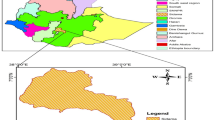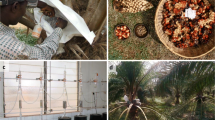Abstract
This study has developed the first formal breeding objective for the Australian tea tree plantation industry. Significant gains in profitability of Australian tea tree (Melaleuca alternifolia) could be made through selection for biomass and oil yield, while maintaining oil quality at acceptable levels. Economic values or weights (EWs), for breeding-objective traits were estimated based on a bio-economic model of a typical production system in Australia. Sensitivity of EWs to the production-system parameters was analysed by what-if scenarios. Selection indices and genetic responses were derived and sensitivity of selection index coefficients to variation in EWs and genetic parameters were analysed by Monte Carlo simulation. The EW for average leaf biomass (LB) and oil content (OC) had the net present value of AU$29.53/kg and AU$2059 per mg/g, respectively. Among the production system parameters studied, discount rate and oil price had large impact on the two EWs, while operating costs changed the EW of LB but did not affect the that of OC. Using optimal selection index, positive expected responses in objective traits LB (36.2 kg/ha/year), OC (4.64 mg/g), and in all selection traits (i.e. juvenile OC, height, leafiness, and 1,8-cineole) were obtained except for terpinen-4-ol, at a 10% selection intensity (i = 1.76). Use of restricted selection index resulted in zero change in either 1,8-cineole or terpinen-4-ol content, but also in an opportunity cost especially in OC. The most important factor affecting the sensitivity of the selection index was the EW for OC.

Similar content being viewed by others
References
Amer PR, Fox GC (1992) Estimation of economic weights in genetic improvement using neoclassical production theory: an alternative to rescaling. Anim Prod 54:341–350
Baker GR, Doran JC, Williams ER, Southwell IA (2007) Breeding and cloning tea tree for greater profitability. RIRDC Publication No. 07/142. RIRDC, Canberra (can be viewed at http://www.rirdc.gov.au)
Butcher PA (1994) Genetic diversity in Melaleuca alternifolia: implications for breeding to improve production of Australian tea tree oil. PhD Thesis, Australian National University, Canberra
Butcher PA, Bell CJ, Moran GF (1992) Patterns of genetic diversity and nature of breeding system in Melaleuca alternifolia (Myrtaceae). Aust J Bot 40:365–375
Butcher PA, Matheson AC, Slee MU (1996) Potential for genetic improvement of oil production in Melaleuca alternifolia and M. linariifolia. New Forest 11:31–51
Colton RT, Murtagh GJ, Drinnan J, Clarke B (2000) Tea tree oil. Agfact P6.4.6, 2nd edn. Agriculture, NSW Orange
Cotterill PP, Dean CA (1990) Successful tree breeding with index selection. CSIRO, Melbourne
Davis RL (1999) Tea tree oil marketing trends. In: Southwell I, Lowe R (eds) Tea tree—the genus Melaleuca. Harwood Academic Publishers, Amsterdam, pp 213–220
Doran JC, Baker GR, Murtagh GJ, Southwell IA (1997) Improving tea tree yield and quality through breeding and selection. RIRDC Research Paper Series No. 97/53. RIRDC, Canberra
Doran JC, Baker GR, Williams ER, Southwell IA (2002) Improving Australian tea tree through selection and breeding (1996–2001). RIRDC Publication No. 02/017. RIRDC, Canberra
EOPAA (2008) Newsletter Number 20. http://www.eopaa.com.au/. Accessed 5 Jan 2010
Falconer DS, Mackay TFC (1996) Introduction to Quantitative Genetics., 4th edn. Longmans Green, Harlow, Essex
Fylstra D, Lasdon L, Watson J, Waren A (1998) Design and use of microsoft excel solver. Interfaces 28:29–55
Gibson JP, Kennedy BW (1990) The use of constrained selection indexes in breeding for economic merit. Theor Appl Genet 80(6):801–805
International Organisation for Standardisation (2004) Oil of Melaleuca, Terpinen-4-ol Type (Tea Tree Oil) (ISO 4730:2004). International Organisation for Standardisation, Geneva
Ivković M, Wu HX, McRae TA, Matheson CA (2006) Developing breeding objective for radiata pine structural wood production II: sensitivity analyses. Can J Forest Res 36(11):2932–2942
Kempthorne O, Nordskog AW (1959) Restricted selection indices. Biometrics 15:10–19
Kinghorn BP, Meszaros SA, Vagg RD (2002) Dynamic tactical decision systems for animal breeding. Proceedings of the 7th world congress on genetics applied to livestock production, August 2002, Montpellier. Session 23: 1–8
Klemperer DW (1996) Forest resource economics and finance. McGraw Hill, New York
Koots KR, Gibson JP (1998) Economic values for beef production traits from a herd level bio-economic model. Can J Anim Sci 78:29–45
Murtagh GJ (1999) Biomass and oil production of tea tree. In: Southwell I, Lowe R (eds) Tea tree—the genus Melaleuca. Harwood Academic Publishers, Amsterdam, pp 109–133
NSW Treasury (2007) NSW Government guidelines for economic appraisal, policy & guidelines papers 7-5. http://www.treasury.nsw.gov.au/__data/assets/pdf_file/0016/7414/tpp07-5.pdf. Accessed 5 Jan 2010
Prastyono (2008) Potential of clones to boost yields in tea tree plantations. MSc Dissertation, Southern Cross University
Ragsdale CT (1998) Spreadsheet modelling and decision analysis: a practical introduction to management science, 2nd edn. International Thomson Publishing, Boston
Vose D (2000) Risk analysis: a quantitative guide. Wiley, New York
Williams LR, Home VN, Asre S (1990) Selection and breeding of superior strains of Melaleuca species to produce low cost, high quality tea tree oil. In: Williams LR, Home VN (eds) Modern phytotherapy—the clinical significance of tea tree oil and other essential oils, vol 2. Macquarie University, Sydney, pp 73–91
Acknowledgments
The authors would like to thank Drs Emlyn Williams and Gary Baker for their help and comments.
Author information
Authors and Affiliations
Corresponding author
Additional information
G. J. Zhang and M. Ivković contributed equally.
Rights and permissions
About this article
Cite this article
Zhang, G.J., Ivković, M., Prastyono et al. Development of an economic selection index for Australian tea tree. Agroforest Syst 82, 51–60 (2011). https://doi.org/10.1007/s10457-010-9354-3
Received:
Accepted:
Published:
Issue Date:
DOI: https://doi.org/10.1007/s10457-010-9354-3




